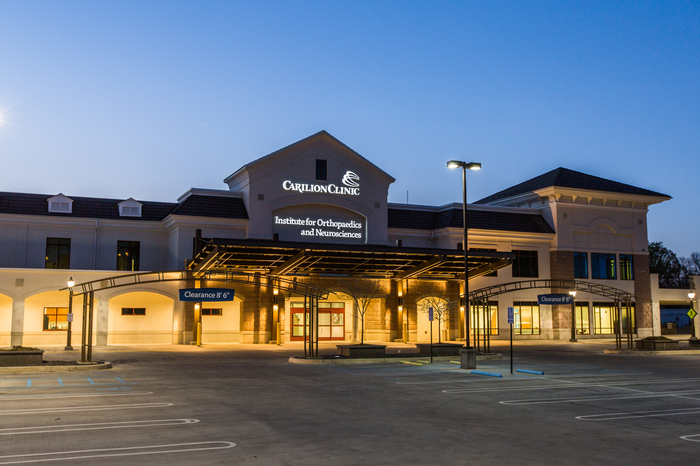Joint Injections for Pain
Joint Injections for Pain
Joint Injections for Pain
When you’re struggling with pain from arthritis or a sports injury, you want quick relief. Joint injections deliver medicine directly into a painful or swollen joint.
Your rheumatologist or orthopaedist may offer them to relieve symptoms and improve movement when other medicines or physical therapy aren’t enough. They work quickly but wear off over time.
At Carilion Clinic, we use ultrasound or other imaging techniques to guide many of our joint injections. Using imaging is safer and helps us be more precise when we inject the medicine. We offer various injections to help with joint pain from all types of arthritis and sports injuries.
When you’re struggling with pain from arthritis or a sports injury, you want quick relief. Joint injections deliver medicine directly into a painful or swollen joint.
Your rheumatologist or orthopaedist may offer them to relieve symptoms and improve movement when other medicines or physical therapy aren’t enough. They work quickly but wear off over time.
At Carilion Clinic, we use ultrasound or other imaging techniques to guide many of our joint injections. Using imaging is safer and helps us be more precise when we inject the medicine. We offer various injections to help with joint pain from all types of arthritis and sports injuries.
Joint injections are treatments that reduce pain and inflammation inside the joints, reducing symptoms. We use joint injections to treat a range of conditions, including many types of arthritis and sports injuries.
We typically use joint injections for:
- Arthritis: Including osteoarthritis, rheumatoid arthritis and psoriatic arthritis
- Bursitis or tendinitis: Inflammation around joints, often in the shoulder, elbow, hip or knee
- Gout or pseudogout: When crystals in the joint cause sudden, painful swelling
- Injury-related pain: To calm inflammation after a strain or sprain
With image-guided joint injections, we use imaging to help guide the needle with the medicine. Seeing this image helps us know precisely where to place the injection.
We use imaging techniques, including:
- Ultrasound: Uses sound waves to create pictures of your joint in real time. A technician moves a small wand over your skin to help the doctor guide the needle.
- X-ray: Creates still images of bones and joints. We sometimes use contrast dye to see the joint space more clearly.
- Fluoroscopy: A type of moving X-ray that shows a live video of the joint. This is especially helpful for deeper or harder-to-reach joints, such as the hip or sacroiliac joint.
We use image guidance when it has the most benefit. Not all injections require using an ultrasound or X-ray. Your care team will talk to you about whether your injection will be image-guided or not.
We most commonly use image-guided joint injections to treat pain and inflammation in:
- Knees, shoulders, elbows, hands and wrists, and feet and ankles: We often use ultrasound in these joints, since they’re easy to access.
- Hips and sacroiliac joints: These are deeper joints. Fluoroscopy is more common for both hip and sacroiliac joint injections.
What Are Image-Guided Joint Injections?
Joint injections are treatments that reduce pain and inflammation inside the joints, reducing symptoms. We use joint injections to treat a range of conditions, including many types of arthritis and sports injuries.
We typically use joint injections for:
- Arthritis: Including osteoarthritis, rheumatoid arthritis and psoriatic arthritis
- Bursitis or tendinitis: Inflammation around joints, often in the shoulder, elbow, hip or knee
- Gout or pseudogout: When crystals in the joint cause sudden, painful swelling
- Injury-related pain: To calm inflammation after a strain or sprain
With image-guided joint injections, we use imaging to help guide the needle with the medicine. Seeing this image helps us know precisely where to place the injection.
We use imaging techniques, including:
- Ultrasound: Uses sound waves to create pictures of your joint in real time. A technician moves a small wand over your skin to help the doctor guide the needle.
- X-ray: Creates still images of bones and joints. We sometimes use contrast dye to see the joint space more clearly.
- Fluoroscopy: A type of moving X-ray that shows a live video of the joint. This is especially helpful for deeper or harder-to-reach joints, such as the hip or sacroiliac joint.
We use image guidance when it has the most benefit. Not all injections require using an ultrasound or X-ray. Your care team will talk to you about whether your injection will be image-guided or not.
We most commonly use image-guided joint injections to treat pain and inflammation in:
- Knees, shoulders, elbows, hands and wrists, and feet and ankles: We often use ultrasound in these joints, since they’re easy to access.
- Hips and sacroiliac joints: These are deeper joints. Fluoroscopy is more common for both hip and sacroiliac joint injections.
There are different types of joint injections.
Corticosteroid injections
We combine a steroid, like cortisone, with a numbing medicine, called an anesthetic. We inject it directly into the joint, reducing pain and inflammation.
A corticosteroid injection helps provide pain relief over several weeks. The pain relief usually lasts about a month, but each person is different. There are special types of extended relief corticosteroids that we sometimes use for osteoarthritis in the knee. This can last as long as three months.
In general, cortisone injections provide fast, but temporary, relief for inflamed joints. Many people have repeat injections. Your care team will talk to you about how many injections are safe for you.
Hyaluronic acid injections
One of the reasons you may have joint pain is that the substance that lubricates your joints has started to break down. This natural lubricant is made of hyaluronic acid (HA). By giving you an injection of HA, we can help replace some of the lost joint lubricant.
With HA injections, you’ll have a dosing schedule, usually over several weeks. Your care team will schedule that with you.
We use HA injections most often for osteoarthritis. Researchers are studying whether HA can also help people with inflammatory arthritis.
Platelet-rich plasma injections
Platelet-rich plasma (PRP) is a way to use part of your own blood to promote joint healing.
First, we draw some of your blood. Then we use a device that isolates concentrated platelets. Platelets are part of your blood that help with wound healing.
We inject this platelet-rich plasma into the painful joint. PRP injections help harness your body’s own healing process, but in a sped-up, highly concentrated way.
Types of Joint Injections
There are different types of joint injections.
Corticosteroid injections
We combine a steroid, like cortisone, with a numbing medicine, called an anesthetic. We inject it directly into the joint, reducing pain and inflammation.
A corticosteroid injection helps provide pain relief over several weeks. The pain relief usually lasts about a month, but each person is different. There are special types of extended relief corticosteroids that we sometimes use for osteoarthritis in the knee. This can last as long as three months.
In general, cortisone injections provide fast, but temporary, relief for inflamed joints. Many people have repeat injections. Your care team will talk to you about how many injections are safe for you.
Hyaluronic acid injections
One of the reasons you may have joint pain is that the substance that lubricates your joints has started to break down. This natural lubricant is made of hyaluronic acid (HA). By giving you an injection of HA, we can help replace some of the lost joint lubricant.
With HA injections, you’ll have a dosing schedule, usually over several weeks. Your care team will schedule that with you.
We use HA injections most often for osteoarthritis. Researchers are studying whether HA can also help people with inflammatory arthritis.
Platelet-rich plasma injections
Platelet-rich plasma (PRP) is a way to use part of your own blood to promote joint healing.
First, we draw some of your blood. Then we use a device that isolates concentrated platelets. Platelets are part of your blood that help with wound healing.
We inject this platelet-rich plasma into the painful joint. PRP injections help harness your body’s own healing process, but in a sped-up, highly concentrated way.
Joint injections aren’t usually a first-line treatment. First, your doctor may prescribe things like:
- Pain medicine and anti-inflammatories that you can take by mouth
- Injected or infused medicines that target inflammation
- Exercises or stretches and physical therapy
If these treatments aren’t working, your care team will talk to you about whether a joint injection can help.
Joint injections are generally safe, and using imaging technology helps make them even safer. However, some people should avoid joint injections. This includes people with bleeding disorders or severe diabetes.
Insurance usually covers joint injections, but our care team will make sure to check your benefits.
Is an Image-Guided Joint Injection Right for Me?
Joint injections aren’t usually a first-line treatment. First, your doctor may prescribe things like:
- Pain medicine and anti-inflammatories that you can take by mouth
- Injected or infused medicines that target inflammation
- Exercises or stretches and physical therapy
If these treatments aren’t working, your care team will talk to you about whether a joint injection can help.
Joint injections are generally safe, and using imaging technology helps make them even safer. However, some people should avoid joint injections. This includes people with bleeding disorders or severe diabetes.
Insurance usually covers joint injections, but our care team will make sure to check your benefits.
Orthopaedic specialists and rheumatologists both offer joint injections. Doctors trained in interventional radiology can also do these injections.
Joint injections don’t require anesthesia or fasting. We do image-guided injections in the doctor’s office or an interventional radiology clinic. It usually takes around 30 minutes.
During the joint injection
We’ll numb the skin around the area to reduce the pain of the needle.
If we’re using ultrasound, we’ll visualize the area on the screen. Seeing the joint allows us to avoid hitting blood vessels or other nearby structures.
The injection itself is very quick. With a steroid injection, the anesthetic starts relieving pain in about an hour. It can take a few days for the cortisone to bring down the inflammation and swelling.
Your care team will tell you if there’s anything you should avoid. Most people don’t have any restrictions after a joint injection.
What Should I Expect?
Orthopaedic specialists and rheumatologists both offer joint injections. Doctors trained in interventional radiology can also do these injections.
Joint injections don’t require anesthesia or fasting. We do image-guided injections in the doctor’s office or an interventional radiology clinic. It usually takes around 30 minutes.
During the joint injection
We’ll numb the skin around the area to reduce the pain of the needle.
If we’re using ultrasound, we’ll visualize the area on the screen. Seeing the joint allows us to avoid hitting blood vessels or other nearby structures.
The injection itself is very quick. With a steroid injection, the anesthetic starts relieving pain in about an hour. It can take a few days for the cortisone to bring down the inflammation and swelling.
Your care team will tell you if there’s anything you should avoid. Most people don’t have any restrictions after a joint injection.
Joint injections are a key part of treatment for many people with arthritis. The experts at Carilion provide the best joint pain care in the area.

Collaborative approach
From orthopaedics and sports medicine to rheumatology, our specialists work together.

Largest orthopaedic practice in Virginia
We have nearly 50 orthopaedic doctors, including more than 35 orthopaedic surgeons, podiatrists and physiatrists. Our size means we see a greater variety of cases and have more experience treating both the simple and the complex.
Why Choose Carilion Clinic?
Joint injections are a key part of treatment for many people with arthritis. The experts at Carilion provide the best joint pain care in the area.
Health and Wellness

4 Ways to Keep Your Joints Happy

Healing Arts: A Vital Addition to Patient Care
Avoid Injury the IRONMAN Way
Get Care at Carilion Clinic
Your path to better health starts here. Explore comprehensive care options and find the support you need for every step of your wellness journey.
Get Care at Carilion Clinic
Your path to better health starts here. Explore comprehensive care options and find the support you need for every step of your wellness journey.
Get Care at Carilion Clinic
Your path to better health starts here. Explore comprehensive care options and find the support you need for every step of your wellness journey.
Get Care at Carilion Clinic
Your path to better health starts here. Explore comprehensive care options and find the support you need for every step of your wellness journey.

